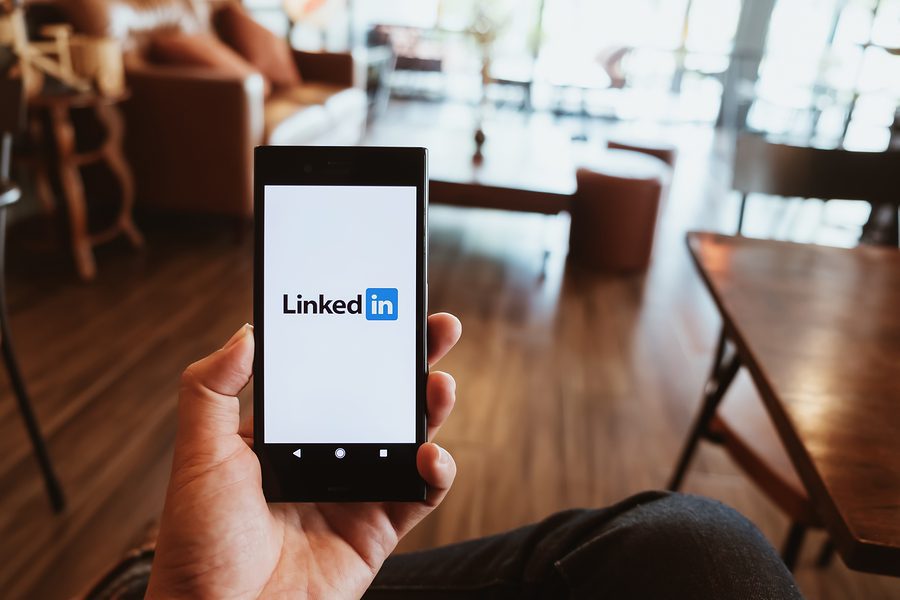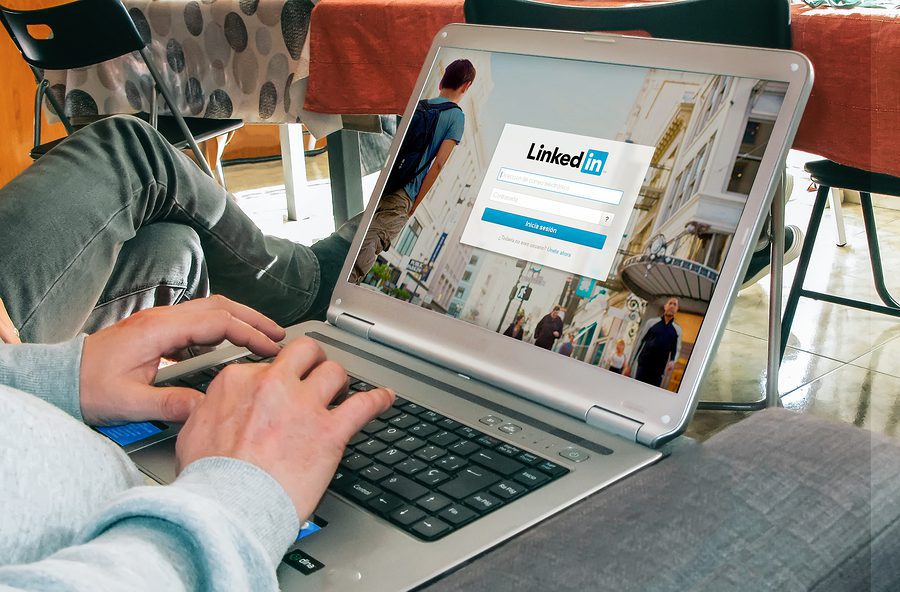
By now we all know about LinkedIn. This social networking platform for professionals to share ideas, promote the companies they own or work for, and network has seen a massive growth rate (we’re talking 1,000%) since it started 13 years ago.
But it’s not unlikely that somewhere along the line, your interest in the social network waned. Maybe it was because could never set up your profile the way you wanted to. Or it seemed like the platform was created more for job seekers than the businesses that employ them.
But while you’ve lost interest, LinkedIn has been growing. And growing! They now have 562 millions users making it a larger online community than Twitter, Snapchat, and Pinterest.
The truth is, LinkedIn is an important marketing tool for B2B companies. According to HubSpot, LinkedIn is 277% more effective for lead generation than Facebook. And a Demand Wave study found that LinkedIn generates leads for 59% of B2B marketers.
So that’s our topic for today. After reading through this game plan, you’ll thoroughly understand how to build a successful profile for your company and effectively market its products and/or services. In short, you’ll be a LinkedIn for B2B pro. Sound like a plan? Great, let’s get this show on the road.
Build a Better Company Profile
Before we dive into any promotional tactics or implement any snazzy networking techniques, we first have to make sure that your company’s profile is in top-top shape. That’s the first step in our LinkedIn for B2B game plan.
Background and Logo Images
Both the background and logo images you choose for your company’s LinkedIn profile are very important. They should resonate with prospects and draw them in. Fortunately, it’s really easy to get these right.
For the logo image, simply use (surprise!) your company’s logo. Studies show that companies with logo images get six times more traffic to their pages.
For the background picture, choose something appealing that reflects what your business does or the way it makes people feel. Many organizations have begun using a “collage” approach.
Percolate is a great example of relevant, quality imagery:

Summary and Company Information Sections
This is your opportunity to tell your brand story. What do you do, who do you help, what are your values and why? Let people know.
You’ll want to keep this section concise while still making it enticing and differentiating your brand from the competition. Sound like a tough task? Just remember to write conversationally, make use of white space (no 10 line paragraphs, please!), and speak directly to your target audience.
The company information section is pretty straightforward. Our only recommendation it that you actually complete it. Add your company website, address, industry, year founded, etc. and update it as needed. It will help you score more leads and build trust with prospects.
A Couple More Profile Tips
Improving the quality of your profile’s images and summary will definitely help you achieve more success on LinkedIn. Here are a few more tips you’ll want to employ as well:
Optimize Your Copy for Search
The copy in your LinkedIn profile is SEO friendly — both in Google and on LinkedIn. Optimizing it for search is essential. Include relevant keywords and your business will appear in searches for those terms, allowing your brand to “meet” more prospects.
Cater to Global Audiences
LinkedIn allows companies to display their pages in over 20 different languages. If your business operates internationally, this is an amazing feature! Now potential customers and clients around the world can engage with your brand in their native tongue.
This doesn’t happen by default, though. You must configure your page for each language. This post shows you how.
Create Showcase Pages
This is a very cool feature that allows companies to highlight specific divisions of their organizations, or certain products and services that they offer.
For example, let’s say that your business sells pianos. You could create a showcase page dedicated to your top seller. Or you could showcase the affordable piano tuning service your company offers. They allow you to narrow down your audience and target specific segments.
Showcase pages also allow for larger header images, more information “above the fold,” and their own analytics information. This means you can track visitor interest in specific products or services that your business offers. Currently, LinkedIn allows up to 10 showcase pages.
Market Your Company for Success
Got your company profile where you want it? Perfect! Now it’s time for step two in our LinkedIn for B2B gameplan — marketing. The real fun is about to begin.
Just like in any other type of promotional endeavour, there are two types of marketing you can do on LinkedIn: inbound and outbound. We’ll discuss each individually.
But first, it’s important to note that due to some of the current limitations to LinkedIn company pages, some of the following tactics may need to be used via your personal profile. Hopefully LinkedIn will add more company page functionality in the near future.
Inbound Marketing Techniques on LinkedIn
Let’s start with inbound. How do you get prospects to come to you on LinkedIn? There are a couple of ways, actually:
Consistently Post Great Content
It’s the basis of modern marketing. Create amazing content that your target audience is interested in and publish it on a regular basis. So what should you post?
You could post links to interesting blog posts or videos — both ones your company has created and ones made by other brands. You could blog directly on LinkedIn (or repurpose older blogs to be posted on the network) that display your thought leadership.
Company news and updates also make for worthwhile posts on LinkedIn for B2B companies. Share what your organization is working on, funny behind the scenes stories, and plans for the future. Whatever you share, try to post at least once per day — preferably in the morning.
Finally, make sure to optimize your headlines, use quality imagery, and include a CTA in all of your LinkedIn posts. This will increase engagement by as much as 98%!
Be Social and Interactive
It always surprises us how many companies expect to publish content on social media and then sit back and watch the leads roll in. It doesn’t work like that. You have to engage your audience and nurture conversation. These are social networks, after all.
Remember to be helpful and friendly. Ask your audience questions and get their opinions on specific issues or ideas. Don’t simply push your products and services 24/7.
In the interest of being social, you should also consider starting a LinkedIn group. Especially if there isn’t already one on a topic that relates to both your brand and your audience. This tactic must be done via a personal profile, though.
How does this look in action? Perhaps your business operates in the solar energy field. You’ve noticed that there are no LinkedIn groups discussing the benefits of solar for commercial buildings. (There may indeed be groups dedicated to this topic; this is just an example.)
So you could create a group that focuses on this topic. You include include commonly used keywords in the title so that it’s easily found by interested professionals. And you would want to consistently post relevant and useful content, start conversations, and engage with members.
Every once in a while you might promote your company and its products. But even when you aren’t marketing your offerings, group members will see your constantly engaging and may click over to your profile to learn more about you and your business. Win!
Outbound Marketing Techniques on LinkedIn
Not the waiting type? You can also use outbound marketing techniques to go find prospects. But, you’ll need to use your personal LinkedIn profile for this approach. Here’s a process to follow:
Start With LinkedIn’s Advanced Search
The first thing you need to do is find quality prospects. The best way to do that on LinkedIn is via Advanced Search. Even free profiles have access to this feature, though it won’t have all the bells and whistles that the paid accounts will.
With the search function, you’ll have the ability to really hone in on your target audience through location, job role, industry and other filters. Once you’ve created a targeted search that you’re happy with, LinkedIn allows you to save it. That way you can return to the results at a later date.
Reach Out In a Professional Manner
When contacting prospects, don’t bombard them with sales messages. They didn’t asked to be contacted by you and aren’t interested in being sold to. At least not yet. Instead, contact them with the intention of building a relationship.
That doesn’t mean you should hide your true purpose. But you should speak to them in a conversational tone, always lead with the benefits they’ll receive, and provide value at every turn.
Here’s an example of a proper prospecting message:
Hi Bob,
My name’s Jim and I work for ABC Incorporated. We’re both a part of the same marketing group here on LinkedIn and I really appreciate your post regarding content marketing trends for the new year. I shared a similar view in a recent post on the topic. (link to content)
At ABC Incorporated we create marketing software for professionals like yourself. Our customers regularly experience 15% increase in leads on average. Would you be interested in learning more about what we do
Thanks for your time,
Jim
This email has a high probability of success because it’s professional, short, value driven and ends with a call to action.
The Art of the Follow Up
Most of the prospects you contact won’t be ready to become customers right away. The real money is in the follow up. You need to stay in contact and continue providing value. Not every day, but often enough so that they begin to remember who you are and associate your messages with value.
We don’t recommend you send any “are you ready now?” messages. Instead, message them once every month or two with something worth their while. A link to an article they might enjoy, for example. It could be something you’ve written or one you found while browsing the web.
Perhaps you send them an invite to an industry conference you’re speaking at. Go all in and get them free tickets if they’re a top quality prospect and you’re able to. You could even let them know about a new product your company has just released if it’s something they would find useful.
Just make sure that you always provide value and aren’t the pushy used car salesman we all loathe. Build a relationship and the sales will come.
LinkedIn Advertising: A Few Quick Tips
LinkedIn advertising may be another effective outbound marketing tactic for your company. When used correctly, this technique can send qualified leads gushing into your pipeline. How does that sound? Here are a few quick tips:
Choose the Right Type of Ad
LinkedIn offers two different Ad formats: Self-Service Ads and LinkedIn Advertising Partner Solutions. Let’s talk about both of them.
- Self-Service Ads: The name says it all. Self-service ad campaigns are those you build and run yourself. You can create sponsored content to share your posts with targeted prospects; text ads, which are the LinkedIn equivalent to Google search ads; video ads — self explanatory; display ads, which are highly visible on LinkedIn; and dynamic ads that show personalized advertising messages based on user activity.
- LinkedIn Advertising Partner Solutions: This ad route gives you all the same options as self-service ads. But, you outsource the entire project to a qualified and experience professional. Maybe you don’t have the time to create, run, and optimize your company’s LinkedIn ads. Or you aren’t a “marketing person.” Either way, a partner solution may be the way to go.
Create Click Worthy Ads
Let’s say you’ve decided to go the self-service route. You’re ready to take on the responsibility. You’re even a little bit excited to dive in and get your hands dirty. But how exactly do you create an ad that moves your business forward?
- An Enticing Headline: Your headline needs to draw prospects in. Make sure that it’s benefit driven and written in language your target audience uses.
- Quality Body Copy: Keep it short and sweet while still including the major details and creating desire. Use number to prove your point when applicable.
- A Strong CTA: Every ad needs a CTA that leads back to your website. Write one that encourages immediate action. “Join Today” is better than “Join.”
- Vivid Imagery: Your ad needs to catch the eye of your prospect. They’ve gotten good at tuning out marketing messages. Make your image memorable.
- Proper Targeting: This is a big one. You could write the greatest ad in the world, but if it’s targeted at the wrong audience, it will fail. Targeting parameters can be saved for future use.
Measure Your Results
Once your ad campaign is created and under way, you need to analyze the results and optimize for success. Try different offers, headlines, CTAs and images to see if your click-through rate can be improved.
A/B test different ads against each other. Just remember to only make one change per test. Any more than that and you won’t be able to pinpoint why one ad performed better than the others.
Optimization is key. Don’t skip this step.
Create Your LinkedIn for B2B Strategy
Okay, we’ve talked tactics. But LinkedIn will only benefit your business if an effective marketing strategy is put into place. That’s what we’ll talk about next.
What Are Your Company Goals
Your company’s marketing efforts can be deemed successful without some goals to measure them by. So that’s where your strategy needs to start.
What are you hoping to achieve by marketing your business on LinkedIn? More leads? Better brand recognition? Develop strategic partnerships? All of these can be completed. You just have to understand what you’re aiming for before you implement a LinkedIn for B2B marketing strategy.
Know Your Audience
Do you know who the ideal customer is for your company? Have you created buyer personas to use in your marketing efforts. If not, that’s the next step.
A proper buyer persona will include demographics information like gender, age, location, and company role. It will also include psychographic details like a prospects dreams, fears, and top challenges.
Until you know exactly who you’re intending to reach and truly understand them, your marketing efforts are dead in the water.
Choose The Right Tactics
If you’ve identified a few company goals and know who your target market is, then you can finally decide on tactics. Tactics come last because the ones you use will completely depend on your goals and audience preference.
Looking to increase sales? LinkedIn ads might be a great platform. Does your audience prefer to read blog posts or watch videos? The answer will dictate the kind of content you create. Make sense?
Optimize Your Approach
Finally, no LinkedIn for B2B marketing strategy is complete without an optimization component. As you begin your quest for LinkedIn dominance, you try many different things. Which ones work and which don’t? You need to analyze the numbers to be sure.
If a tactic failed miserably, ask why. Was it because your company didn’t execute properly, or is the tactic just not a good fit for your business and target audience?
By analyzing and optimizing your approach, you’ll get the results you want faster and more affordably. That’s what you’re after, right?
Let’s Wrap Up
LinkedIn for B2B companies is an amazing tool when used correctly. It will allow you to network with other like minded businesses, reach more and better prospects, and elevate your brand in new and exciting ways.
Remember to get your company page squared away before you attempt any major marketing efforts. And take the time to implement a complete marketing strategy rather than simply apply random tactics. Finally, analyze your results and optimize them for greater success. You got this!
What are your thoughts on LinkedIn for B2B companies? Have you experimented with any of the strategies or tactics outlined in this game plan? We’d love to hear the details in the comment section below.
Jacob Thomas is a freelance copywriter and content marketer based in Bend, OR. His professional writing approach has helped numerous businesses gain more traffic, leads and sales. To contact Jacob, visit www.jtcopywriting.com.



